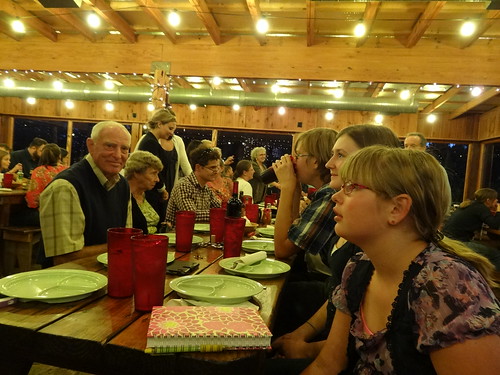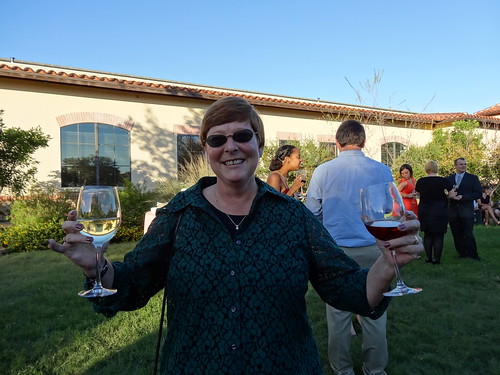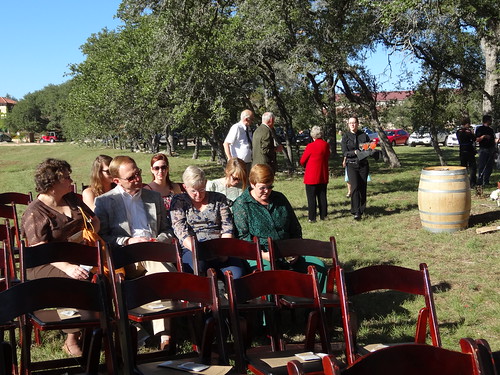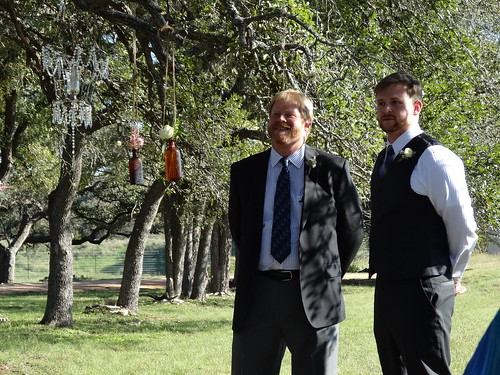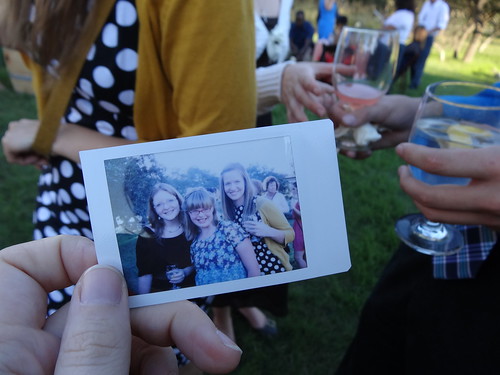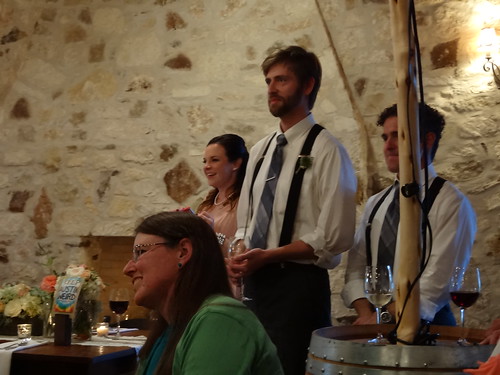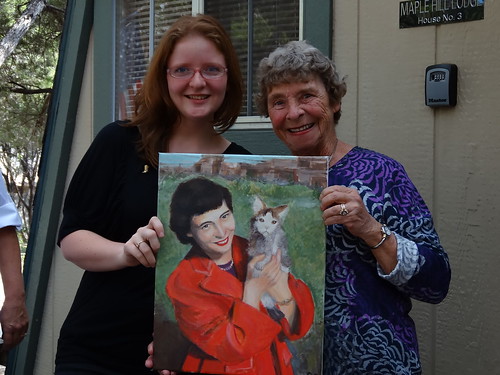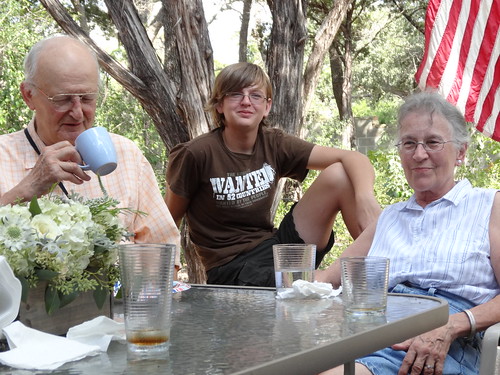Having written on Kazakh weddings for American readers, I’d also like to cover a Real American wedding for my Kazakh readers. Three months after the Kazakh wedding, I attended a family wedding in America.
(See also the way comedian Stephen Colbert officiated a wedding this week, in the wake of the American government shutdown: here and here.)
American Marriages:
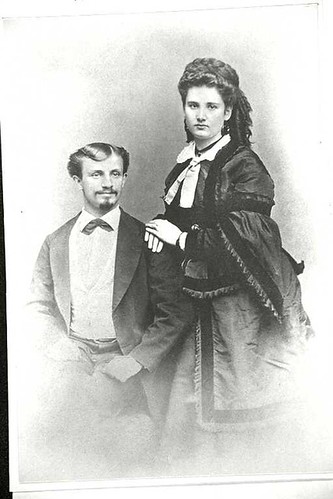
American marriages are usually a “love match.” After dating an assortment of partners, Rob and Elise each moved separately to Texas for work. I’ll use their real names… because their weddings pics are already all over the internet. Both are from the same town in Ohio, had common friends, but didn’t meet until she came to his workplace in Austin one day to change her cell phone.
They began dating, and after a few months Rob traveled back to Ohio to visit Elise’s father and ask for her hand in marriage before proposing.
“I know something you don’t know!” Her father said he wanted to tell his daughter, but refrained. Rob proposed to Elise and she accepted; they announced their engagement in the traditional 2000s way: a change of Facebook status and an Instagram photo of the ring.
This was followed by a series of outdoors engagement photos showing the couple looking adorably in love, in casual dress.
One photo was used on the “Save the Date” cards which were sent out to family and friends. These are sent prior to the official invitation to the wedding and food reception. A website was set up. And Rob and Elise spent months planning for the wedding; with the help of Elise’s family, they paid for photographers, flowers, drinks; food; an outdoor ceremony at a local vineyard.
Official Papers
They also go to get the ‘marriage license’ from the courthouse, which you do before the ceremony itself. Usually, at a ceremony a pastor marries two young people, if their families are even vaguely religious. At this wedding, my father is officiating the wedding of his own son. It’s a bit odd, but dad worked as a Christian pastor off and on for years.
What I find bizarre, though, is that years of experience in Christian ministry isn’t enough to allow you to marry someone in a private ceremony in America. Instead, what you need is a piece of paper that the government recognizes. A religious ordination. And the requirements vary by state, but each state ‘controls’ the individual marriages of any human beings in their territory.
So dad goes online to the Universal Life Church, where for $8, anyone in America can get a piece of paper ordaining them as a ‘minister’ (religious title) and letting them marry others in a way that the government recognizes… This certification by the Universal Life Church online brings jokes and snickers from my aunts and uncles: “You better check your certificates, Rob!”
Wedding Eve: the Rehearsal Dinner
Both families traveled from Ohio. The day before the wedding, those in the wedding party (bride, groom, parents, bridesmaids, groomsmen) run through a rehearsal of the wedding at the site. Afterwards, the extended family gathers for a rehearsal dinner.
We drive long winding roads and halt frequently in the Austin traffic, skirting the edge of town until we come to a small country road. We drive past the Salt Lick restaurant, but Dad tells us by phone to turn back; go to the Salt Lick BBQ and drive to the back of the parking lot.
Wedding Day: Late October
The family still sleeps in three cabins along the lakes. Back inside, I pull off my coat and wake Nen up. We make coffee and walk to get bagels and cake from Mom’s cabin. My young cousin, Leah*, brushes her luxuriant long hair, full past the length of her slim waist. My teen brother, Nathan*, has slicked his hair to the side. My preteen sister hasn’t bothered to brush hers.
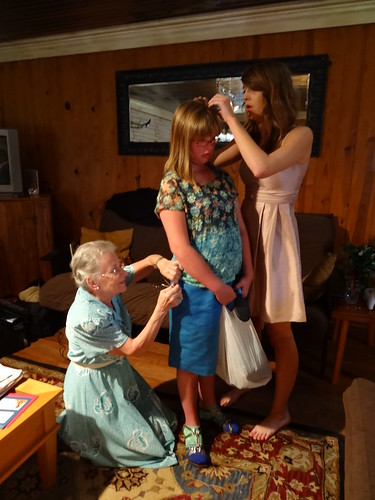
After one o’clock, we quickly begin preparing for the wedding. My brother Chip is long-gone, setting up for the outdoor wedding at a local winery. His girlfriend irons her pleated pink dress. Nen sews up the back of her dress and adds a mustard-colored sweater and heels; I iron my silk skirt. We run to our cars; I ride with my mother’s parents to the wedding, angular redbrick houses sprouting between the trees.
As Grandpa drives, Grandma chatters about the upcoming wedding. “Rob and Elise have a wedding planner,” she says. “Your mom is very impressed. The wedding planner is very organized, ‘don’t worry about this, this is the only job you have to do, and what you have to do.’” I listen, sticky hard-edged Jolly Rancher in my mouth.
We’ve got a Friday wedding, which is a bit unusual. “There was a three year waiting list for Saturday weddings,” Grandma explains.
“It sure isn’t for the trees, there are no trees here,” Grandpa wrinkles his face at the Texas landscape.
“Well, it’s a winery, they don’t come for the trees,” Grandma corrects him, looking down at the MapQuest directions.
On Wedding Traditions in America
I ask Grandma about wedding traditions in America. She tells me that the groom pays for the rehearsal dinner, but the bride pays for the food at the wedding, and the wedding itself. The groom should pay for the flowers and of course the bride’s wedding ring. Grandma tells me that the day before, my parents paid for the food, but my brother bought the alcohol.
I ask about traditions for the wedding, and she repeats that there is usually a bachelor party for the groom and his friends, before the wedding. It’s possible the maid of honor will have a shower for the gals. “Different areas have different customs, like a particular church will have things they do, but they have scads and scads of magazines, that tell you what to do,” Grandma tells me.
The Outdoor Wedding
We arriving just before 4pm, the sun slanting across chairs laid out on the vineyard lawn. On the other side of the gravel driveway, up on the lawn by the Duchman Winery, peach-clothed tables are being laid with citrus water and strawberry lemonade. The catering staff gather the drinks and serve the guests from little trays.
Family wanders around, girls in short dresses with heels, women with sparkling shirts, old women with carefully pressed hair and bright lipstick. My father and Elise’s mother walk around entertaining and chatting with people; aunts give everyone hugs; my mother and aunt play the cello and violin from beneath the trees, as the audience begins to assemble.
We sit on wooden chairs decked with flowers in glass jars; glass bottles shine in the afternoon sun, hanging from the trees overlooking a field. The sun is bright on our shoulders as we wait; Elise’s family hold the bulletins over their heads to block the sun. My family makes jokes and ducks away from the photographers.
Eventually the wedding planner calls everyone together. We sit in seats, in rows: The bride’s family is on the left of the aisle, the groom’s family to the right. A DJ puts on music and the wedding party walks up the aisle in our familiar ritual: bridesmaids and groomsmen, hand in hand; parents and grandparents led to the front. Then Dad and Rob wait for the bride:
My father is a past minister and current computer programmer by trade, but leads the ceremony. Online ordination certificate in hand, he asks, who gives this woman to be Rob’s wife?
“I do,” Elise’s father says, and hugs his daughter before letting her go.
Elise stands and holds Rob’s hands, nervously. They listen to my father’s sermon:
marriage is hard, you’re taking it on faith, you’re making a promise to all of us, and we’ll help you. Your relationship is a representation of God’s relationship to his people; Rob, you are to love your wife, and show that love, and put her first; Elise, you are to submit to and respect your husband; both of you are to submit to and love each other. This is the difficult thing.
Then Dad asks if they pledge this marriage in sickness and in health, in poverty and in wealth, as long as you both shall live, and they say I do.
They read individualized vows they have written for each other – I promise to love you, to avoid complacency, to trust in you, to put you first. These are becoming more popular with young Americans who want tradition, but some of their own thoughts inserted into the ceremony as well.
“Then by the power invested in me by God, and this community — and I suppose I am supposed to say the State of Texas – I now pronounce you man and wife,” my father ends.
The couple kiss. They are introduced, her name now folded into his, as “Mr and Mrs. Rob …”
And they walk down the aisle as we toss dried lavender petals at their hair.
After the Ceremony
Next there are pictures, of families, the couple, the wedding party:
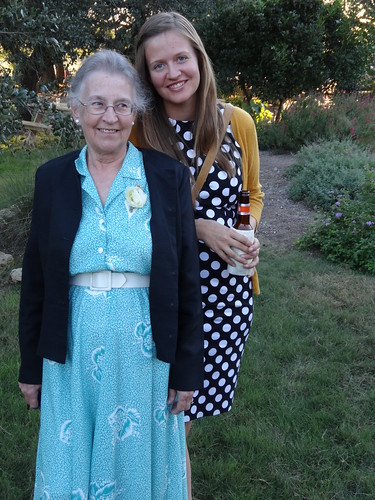
Then we’re brought inside the winery’s main hall, milling around to examine the cupcakes and tiramisu on the dessert table; the pale flowers nestled among books and candles on our tables, and the pictures of Rob and Elise hung up on clothespins.
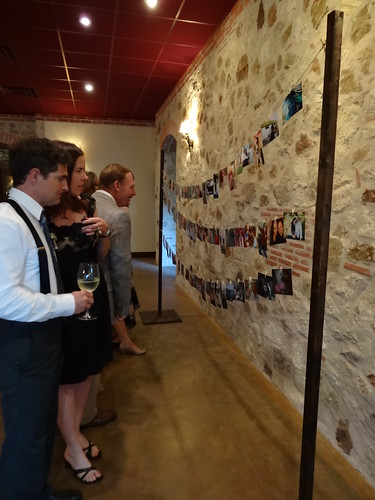
And Elise’s father, an eloquent lawyer, stands and speaks about his long-ago dream when Elise was born, praying for Rob and his parents, that Rob would be raised to know God and prepared for his daughter. It’s a miracle, the family repeats, that you had so many opportunities to meet in Ohio, but never met till you both came to Austin.
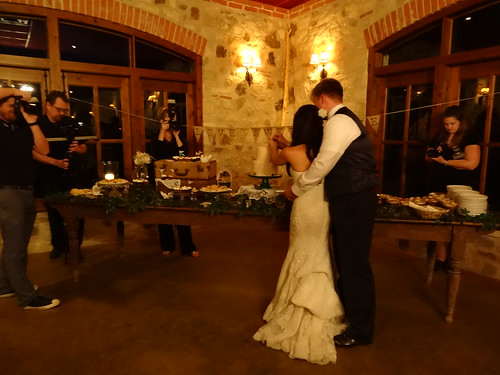
Together, Rob and Elise cut the cake, feeding slivers to each other.
Then the dances: Elise with her father, Rob with his mother, the focus of the crowd’s attention. After this, everyone is permitted to dance together; the DJ takes requests for music:

Around 10:15 the music ends, and the two mothers begin to gather the table displays and hand out flowers to the guests. As we leave, the guests line up with heavy sparklers in our hands, long metal rods with gunpowder caked on them. They sparkle and flare fire as Rob and Elise walk in between them, one last shot for the photographers:
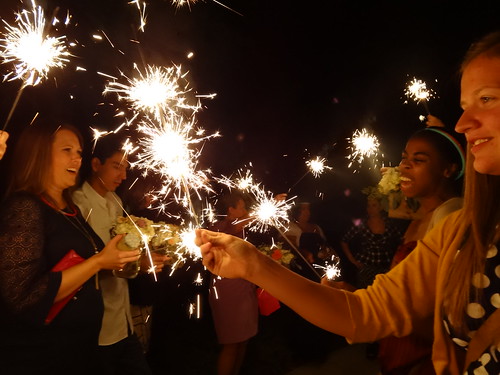
We stop at the grocery store for more drinks, before going home and falling asleep.
More on Wedding Traditions
So what of this wedding? I know more of the American wedding ‘script’ than I do of the Kazakh, and of course there are variations here. Traditionally:
- The bride and groom shouldn’t see each other on the wedding day before the ceremony starts – I don’t know if that happened or not.
- The bride should wear “something old and something new, something borrowed, something blue.” – I don’t know.
- There was no flower girl (little girl carrying flowers), nor ring bearer (little boy carrying a ring), probably because the siblings were all older.
- There was no smashing of cake in each others’ faces – I view this as a good thing.
- There was no bouquet toss and garter toss.
- My father does asks me to note that there were drunk uncles present: “You have to include a section on the crazy drunk uncle. It’s a standard part of an American wedding, right?”
The next day, Rob and Elise show up to our house, tired and dressed casually. We lounge around the rented cabins and talk. I learn that the wedding was probably twice as expensive as the one in Kazakhstan; in addition, the couple was given enough money for a short honeymoon in Europe. Umm.. and best of all, I got to give my grandpa a present: a picture I painted of her while living in Kazakhstan, copied from a photo that’s 50 years old.

